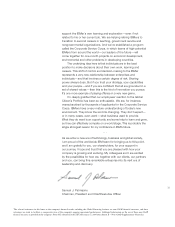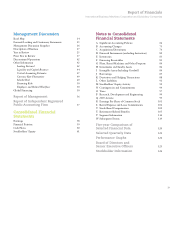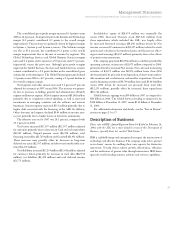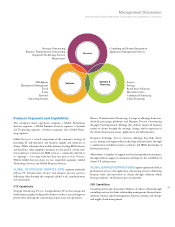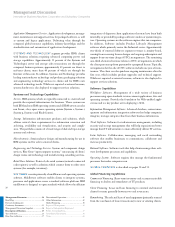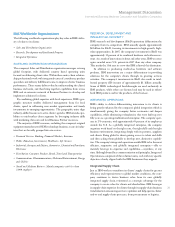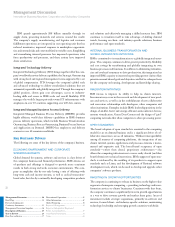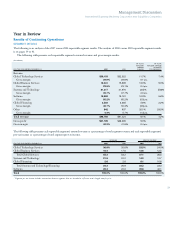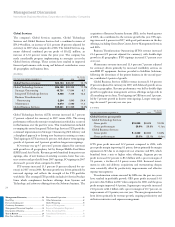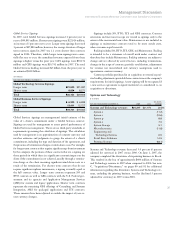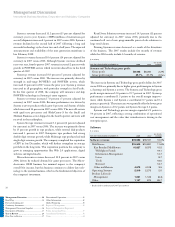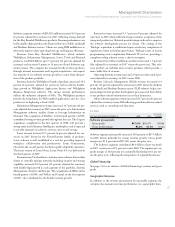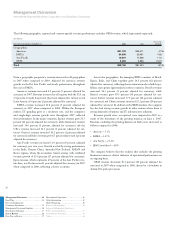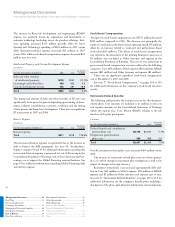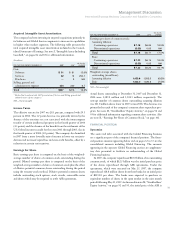IBM 2007 Annual Report Download - page 23
Download and view the complete annual report
Please find page 23 of the 2007 IBM annual report below. You can navigate through the pages in the report by either clicking on the pages listed below, or by using the keyword search tool below to find specific information within the annual report.Management Discussion
International Business Machines Corporation and Subsidiary Companies
21
IBM Worldwide Organizations
The following worldwide organizations play key roles in IBM’s deliv-
ery of value to its clients:
U Sales and Distribution Organization
U Research, Development and Intellectual Property
U Integrated Operations
SALES AND DISTRIBUTION ORGANIZATION
The company’s Sales and Distribution organization manages a strong
global footprint, with dedicated country based operating units
focused on delivering client value. Within these units, client relation-
ship professionals work with integrated teams of consultants, product
specialists and delivery fulfillment teams to improve clients’ business
performance. These teams deliver value by understanding the client’s
business and needs, and then bring together capabilities from across
IBM and an extensive network of Business Partners to develop and
implement solutions for clients.
By combining global expertise with local experience, IBM’s geo-
graphic structure enables dedicated management focus for local
clients, speed in addressing new market opportunities and timely
investments in emerging opportunities. The geographic units align
industry-skilled resources to serve clients’ agendas. IBM extends capa-
bilities to mid-market client segments by leveraging industry skills
with marketing, ibm.com and local Business Partner resources.
The majority of IBM’s revenue, excluding the company’s original
equipment manufacturer (OEM) technology business, occurs in indus-
tries that are broadly grouped into six sectors:
U Financial Services: Banking, Financial Markets, Insurance
U Public: Education, Government, Healthcare, Life Sciences
U Industrial: Aerospace and Defense, Automotive, Chemical and Petroleum,
Electronics
U Distribution: Consumer Products, Retail, Travel and Transportation
U Communications: Telecommunications, Media and Entertainment, Energy
and Utilities
U Small and Medium Business: Mainly companies with less than
1,000 employees
RESEARCH, DEVELOPMENT AND
INTELLECTUAL PROPERTY
IBM’s research and development (R&D) operations differentiate the
company from its competitors. IBM annually spends approximately
$6 billion for R&D, focusing its investments in high-growth, high-
value opportunities. In 2007, the company’s investment in R&D was
approximately 15 percent of its combined hardware and software rev-
enue. As a result of innovations in these and other areas, IBM was once
again awarded more U.S. patents in 2007 than any other company.
This marks the 15th year in a row that IBM achieved this distinction.
In addition to producing world-class hardware and software
products, IBM innovations are a major differentiator in providing
solutions for the company’s clients through its growing services
activities. The company’s investments in R&D also result in intel-
lectual property (IP) income of approximately $1 billion annually.
Some of IBM’s technological breakthroughs are used exclusively in
IBM products, while others are licensed and may be used in either/
both IBM products and/or the products of the licensee.
INTEGRATED OPERATIONS
IBM’s ability to deliver differentiating innovation to its clients is
being greatly enhanced by the company’s global integration which is
simultaneously giving the company better economics and deeper
capabilities, while eliminating redundancies that were built up over
fifty years as a growing multinational enterprise. The company oper-
ates in 170 countries, with approximately 69 percent of its employees
outside the U.S. As a globally integrated enterprise, the company
organizes work based on the right costs, the right skills and the right
business environment, integrating deeply with its partners, suppliers
and clients. Being global is about gaining access to talent and skills
and then scaling them globally to develop new, distinctive capabili-
ties. The company’s integrated operations enable IBM to be the most
efficient, responsive and globally integrated enterprise — able to
instantly leverage its expertise and capabilities — anywhere, at any
time. Although bound by a common mission and principles, Integrated
Operations is comprised of three distinct units, each with very specific
objectives closely aligned with the IBM businesses they support.
Integrated Supply Chain
Just as IBM works to transform its clients’ supply chains for greater
efficiency and responsiveness to global market conditions, the com-
pany continues to derive business value from its own globally
integrated supply chain, reinvented as a strategic advantage for the
company to create value for clients and shareholders. IBM leverages
its supply-chain expertise for clients through its supply-chain business
transformation outsourcing service to optimize and help operate clients’
end-to-end supply-chain processes, from procurement to logistics.


